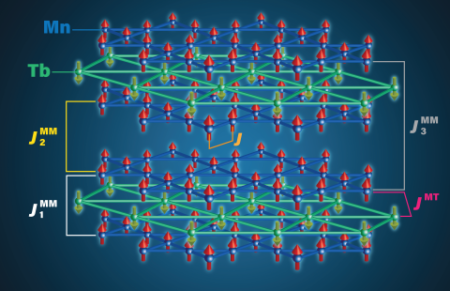Sep
1
Breakthrough In Magnetic Materials Should Save Electricity
September 1, 2022 | Leave a Comment
Scientists from the U.S. Department of Energy’s Ames National Laboratory and Oak Ridge National Laboratory conducted an in-depth investigation of the Kagome layered topological material TbMn6Sn6 to better understand it and its magnetic characteristics. These results could impact future technology advancements in fields such as quantum computing, magnetic storage media, and high-precision sensors.
Kagomes are a type of material whose structure is named after a traditional Japanese basket weaving technique. The weave produces a pattern of hexagons surrounded by triangles and vice-versa. The arrangement of the atoms in Kagome metals reproduces the weaving pattern. This characteristic causes electrons within the material to behave in unique ways.

Graphical representation of the crystal structure of the TbMn6Sn6 material at the atomic level. Here the Mn and Tb atoms appear as blue and green balls, respectively. Lines connecting near neighbors reveal the Mn Kagome and Tb triangular lattices. The magnetism present on this element is represented by arrows located on each individual atom. The magnetic interactions acting within and in-between the different atomic planes are displayed by the square brackets and labeled by the letter “J” with the subscript M and T used to denote the Mn or Tb elements they link. Image Credit: Ames Laboratory. Click here for the link to the press release offering a larger image.
Solid materials have electronic properties controlled by the characteristics of their electronic band structure. The band structure is strongly dependent on the geometry of the atomic lattice, and sometimes bands may display special shapes such as cones. These special shapes, called topological features, are responsible for the unique ways electrons behave in these materials. The Kagome structure in particular leads to complex and potentially tunable features in the electronic bands.
Using magnetic atoms to construct the lattice of these materials, such as Mn in TbMn6Sn6, can further help inducing topological features. Rob McQueeney, a scientist at Ames Lab and the project leader, explained that topological materials “have a special property where under the influence of magnetism, you can get currents which flow on the edge of the material, which are dissipationless, which means that the electrons don’t scatter, and they don’t dissipate energy.”
The team set out to better understand the magnetism in TbMn6Sn6 and used calculations and neutron scattering data collected from the Oak Ridge Spallation Neutron Source to conduct their analysis. Simon Riberolles, a postdoc research associate at Ames Lab and member of the project team, explained the experimental technique the team used. The technique involves a beam of neutron particles which is used to test how rigid the magnetic order is. “The nature and strength of the different magnetic interactions present in the materials can all be mapped out using this technique,” he said.
They discovered that TbMn6Sn6 has competing interactions between the layers, or what is called frustrated magnetism. “So the system has to make a compromise,” McQueeney said, “Usually what that means is that if you poke at it, you can get it to do different things. But what we found out in this material is that even though those competing interactions are there, there are other interactions that are dominant.”
This is the first detailed investigation of the magnetic properties of TbMn6Sn6 to be published. “In research, it’s always exciting when you figure out you understand something new, or you measure something that has not been seen before, or was understood partially or in a different manner,” Riberolles said.
McQueeney and Riberolles explained that their findings suggest the material could potentially be adjusted for specific magnetic characteristics, for example by changing the Tb for a different rare earth element, which would change the magnetism of the compound. This fundamental research paves the way for continued advances in Kagome metals discovery.
***
This is just step one, accomplished. What this research will lead to is likely to apply to a longer list than what is noted above. Electromagnets and electrical windings or wire run round and round something are to create a magnetic field. The basic problem is those wires are long and experience “line loss” as heat. The research has a specialty list, but there are huge numbers of magnets all ready in use and millions more made every year.
Those magnets make motors go and transformers deliver power to homes and businesses among with an immense list of other applications.
This is important work in energy savings and making more power available for less electrical expense. Lets hope this team’s work accelerates and offers ever more and soon, scaleable results.

